In this article, we will discuss electrical slip ring and various types of slip rings. The slip ring is a very important means of energy transfer from a moving part to a stationary part.
What is a Slip Ring?
An electromechanical device that is used to establish a connection between a stationary system and a rotatory system is known as an electrical slip ring. The slip ring is used in different types of electrical devices like in electric motors. The most common application of an electrical slip ring is in a slip-ring induction motor. Where we connect a stationary electric supply to a rotating wound-type rotor.
The slip ring is also referred to as a rotating electrical connector or electrical rotary joint or electric swivel. The use of a slip ring makes it easy to establish an electrical connection between two such systems where one is rotating and another is stationary.
Working of Slip Ring
The whole slip ring assembly of connecting a rotating system to a stationary system consists of two main parts namely a metal ring and a contact brush. The number of metal rings and contact brushes depends on the type and design of the electrical machine.
Metal rings are made up of conducting materials like copper and contact brushes are made up of graphite (carbon) or sometimes phosphor bronze. In practice, we use carbon brushes, but in heavy-duty applications, contact brushes made up of phosphor bronze are preferred because they have good conductivity and more life as compared to carbon brushes.
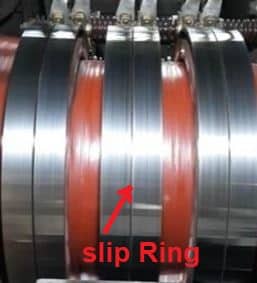
Brushes maintain contact with metal rings and the required pressure force to maintain the contact is provided by a spring installed in the brush holder.
Types of Slip Rings
Depending on the construction and size, there are different types of electrical slip rings available as-
- Pancake Slip Ring
- Mercury Contact Slip Ring
- Through Hole Slip Ring
- Ethernet Slip Ring
- Miniature Slip Ring
- Fibre Optic Slip Ring
- Wireless Slip Ring
1. Pancake Slip Ring
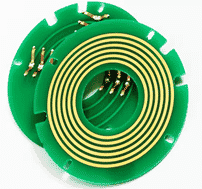
In the case of the pancake slip ring, conductors are arranged on a flat disk as shown in figure-1. This disc is then mounted on the rotor shaft of the machine. The pancake slip ring has a flat shape; thus, it is also called a flat slip ring or platter slip ring.
The axial length of the pancake slip-ring is smaller. For this reason, this ring is used in such applications where space is limited to place it. However, the weight and volume of this type of slip ring is relatively more. Also, these slip rings have greater capacitance and brush wear.
2. Mercury Contact Slip Ring
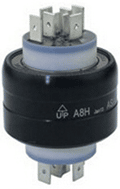
The slip ring in which the mercury contacts are used as the conducting medium for electricity is referred to as a mercury contact slip ring. Thus, this type of slip ring can conduct electricity with the help of liquid metal under normal temperature conditions.
This type of slip ring shows greater stability and less electronic noise, and hence it is more reliable and economical for industrial applications. The major drawback of the mercury slip-ring is that it may create safety concerns because mercury is a toxic substance. Therefore, the use of mercury contact slip ring is prohibited in applications like food manufacturing, pharmaceutical, etc.
3. Through Hole Slip Ring
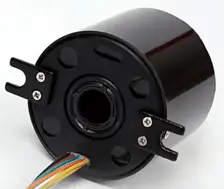
Through hole slip-ring is so named because it has a hole in its center. The through-hole slip-ring is used in such electrical devices in which we need to transmit signals with 360° rotation. The through-hole slip-ring is installed with a flange on a sleeve bracket. Therefore, it has a hole in the center to mount it on the rotor shaft without affecting its cables during rotation.
This type of slip-ring has a longer lifespan and requires low maintenance. Also, the electronic noise caused by this slip ring is less. We usually found this type of slip ring in routing hydraulic pneumatic passages, and in high-frequency joints.
4. Ethernet Slip Ring
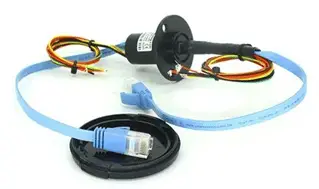
The ethernet slip ring is used in such electrical devices that are used to transfer ethernet protocols. These slip rings are designed to meet the requirements of impedance matching, reducing losses, etc.
While selecting an ethernet slip ring for a particular application, the following are the three crucial factors that we must consider-
- Cross-talk
- Insertion loss
- Return loss
5. Miniature Slip Ring
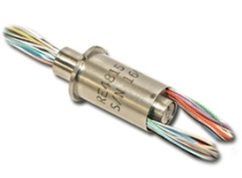
As its name implies, it is a small-sized slip ring specially designed to use in small devices for transferring signals and power. These slip rings are mainly used in control panels, sensors, video transmitters, etc.
6. Fiber Optic Slip Ring
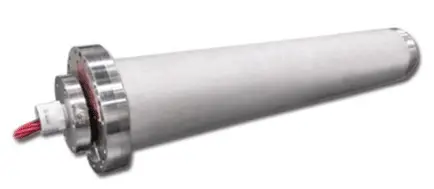
Fiber optic slip, also known as fiber optic joint, is used in devices like sensors, video transmitters, radar, medical instruments, etc. These slip rings are designed to transfer signals across rotating devices when we need to transfer a large amount of data.
7. Wireless Slip Ring
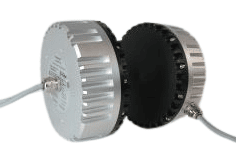
As its name implies, it is a slip ring that can transfer signals and power wirelessly. This type of slip ring uses an electromagnetic field to perform its function. This electromagnetic field is produced by the coils which are placed in the rotating receiver and the stationary transmitter. The most significant advantage of the wireless slip ring is that there is no mechanical contact, hence its life is relatively longer. Due to less wear and tear, it requires less maintenance. However, there is a fixed limit of power that can be transmitted between the coils.
Conclusion
Thus, in this article, we discussed electrical slip ring and their operation. Also, we discussed the different types of slip rings.